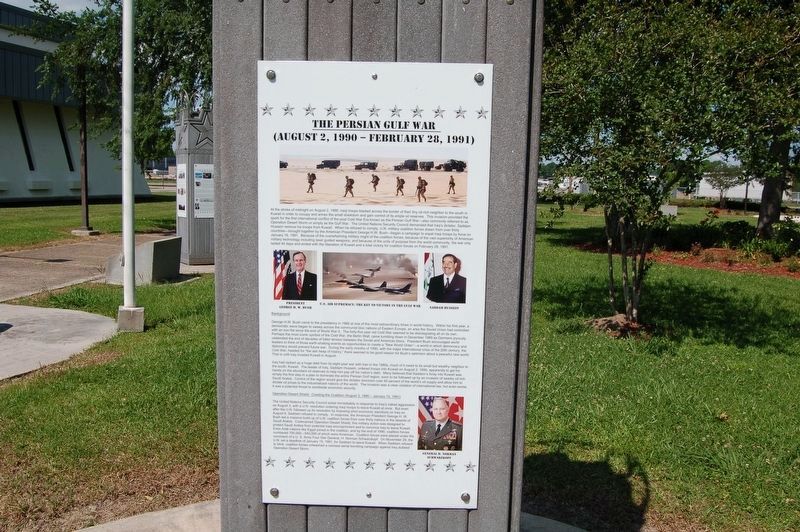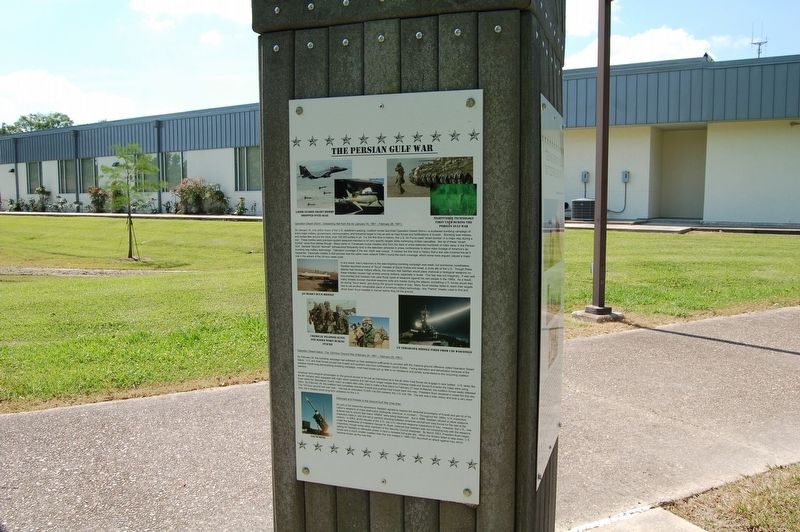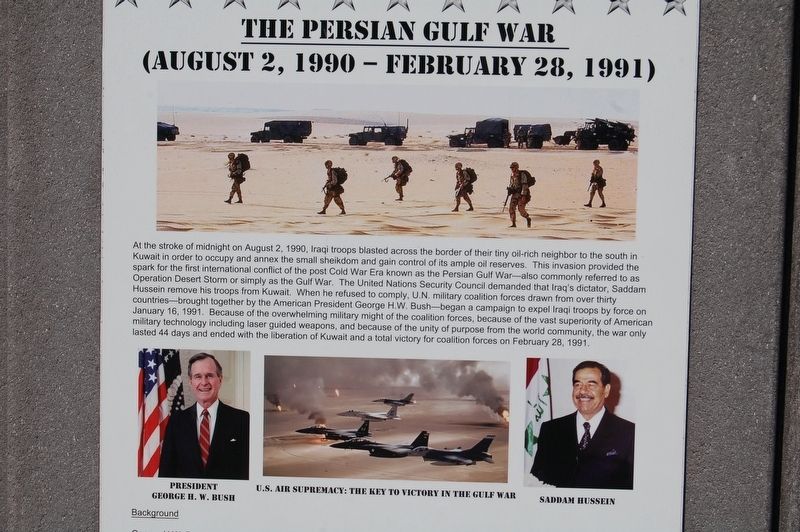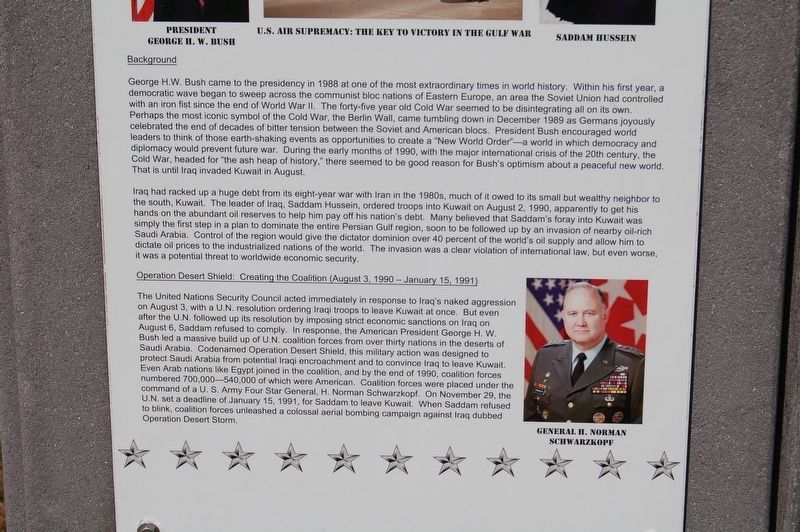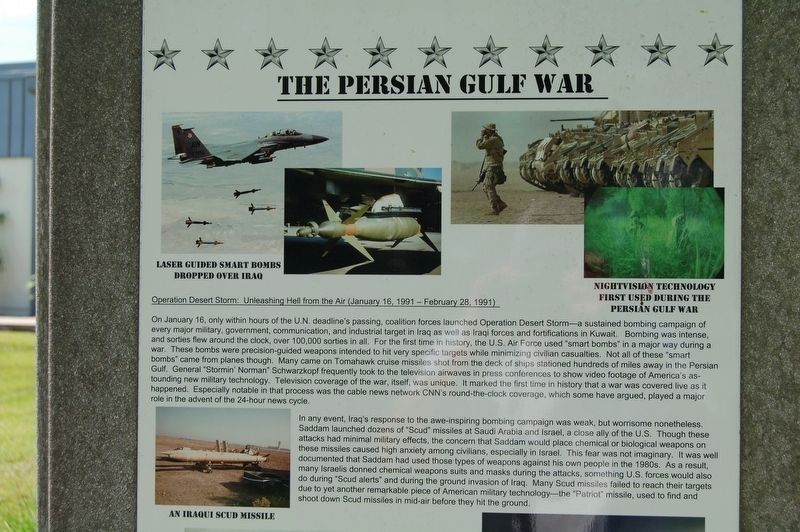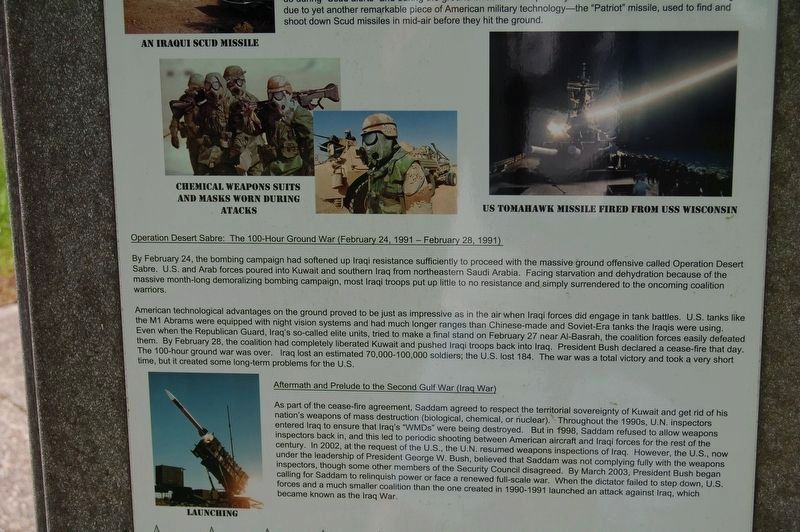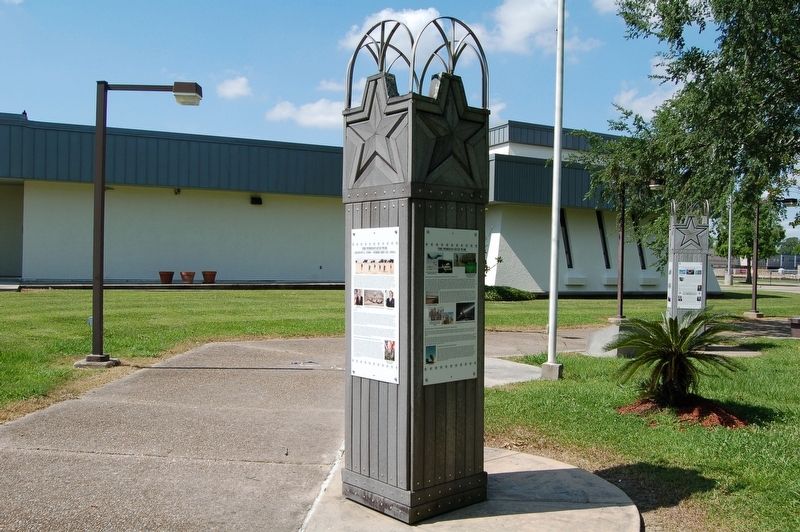The Persian Gulf War
August 2, 1990-February 28, 1991
At the stroke of midnight on August 2, 1990, Iraqi troops blasted across the border of their tiny oil-rich neighbor to the south in Kuwait in order to occupy and annex the small sheikdom and gain control of its ample oil reserves. This invasion provided the spark for the first international conflict of the post Cold War Era known as the Persian Gulf War—also commonly referred to as Operation Desert Storm or simply as the Gulf War. The United Nations Security Council demanded that Iraq's dictator, Saddam Hussein remove his troops from Kuwait. When he refused to comply, U.N. military coalition forces drawn from over thirty countries—brought together by the American President George H.W. Bush—began a campaign to expel Iraqi troops by force on January 16, 1991. Because of the overwhelming military might of the coalition forces, because of the vast superiority of American military technology including laser guided weapons, and because of the unity of purpose from the world community, the war only lasted 44 days and ended with the liberation of Kuwait and a total victory for coalition forces on February 28, 1991.
Background
George H.W. Bush came to the presidency in 1988 at one of the most extraordinary times in world history. Within his first year, a democratic wave began
to sweep across the communist bloc nations of Eastern Europe, an area the Soviet Union had controlled with an iron fist since the end of World War II. The forty-five year old Cold War seemed to be disintegrating all on its own. Perhaps the most iconic symbol of the Cold War, the Berlin Wall, came tumbling down in December 1989 as Germans joyously celebrated the end of decades of bitter tension between the Soviet and American blocs. President Bush encouraged world leaders to think of those earth-shaking events as opportunities to create a “New World Order" —a world in which democracy and diplomacy would prevent future war. During the early months of 1990, with the major international crisis of the 20th century, the Cold War, headed for “the ash heap of history," there seemed to be good reason for Bush's optimism about a peaceful new world. That is until Iraq invaded Kuwait in August.Iraq had racked up a huge debt from its eight-year war with Iran in the 1980s, much of it owed to its small but wealthy neighbor to the south, Kuwait. The leader of Iraq, Saddam Hussein, ordered troops into Kuwait on August 2, 1990, apparently to get his hands on the abundant oil reserves to help him pay off his nation's debt. Many believed that Saddam's foray into Kuwait was simply the first step in a plan to dominate the entire Persian Gulf region, soon to be followed up by an
invasion of nearby oil-rich Saudi Arabia. Control of the region would give the dictator dominion over 40 percent of the world's oil supply and allow him to dictate oil prices to the industrialized nations of the world. The invasion was a clear violation of international law, but even worse, it was a potential threat to worldwide economic security.Operation Desert Shield: Creating the Coalition (August 3, 1990 – January 15, 1991)
The United Nations Security Council acted immediately in response to Iraq's naked aggression on August 3, with a U.N. resolution ordering Iraqi troops to leave Kuwait at once. But even after the U.N. followed up its resolution by imposing strict economic sanctions on Iraq on August 6, Saddam refused to comply. In response, the American President George H. W. Bush led a massive build up of U.N. coalition forces from over thirty nations in the deserts of Saudi Arabia. Codenamed Operation Desert Shield, this military action was designed to protect Saudi Arabia from potential Iraqi encroachment and to convince Iraq to leave Kuwait. Even Arab nations like Egypt joined in the coalition, and by the end of 1990, coalition forces numbered 700,000—540,000 of which were American. Coalition forces were placed under the command of a U. S. Army Four Star General, H. Norman Schwarzkopf. On November 29, the U.N. set a deadline of January 15, 1991,
for Saddam to leave Kuwait. When Saddam refused to blink, coalition forces unleashed a colossal aerial bombing campaign against Iraq dubbed Operation Desert Storm.On January 16, only within hours of the U.N. deadline's passing, coalition forces launched Operation Desert Storm-a sustained bombing campaign of every major military, government, communication, and industrial target in Iraq as well as Iraqi forces and fortifications in Kuwait. Bombing was intense, and sorties flew around the clock, over 100,000 sorties in all. For the first time in history, the U.S. Air Force used “smart bombs” in a major way during a war. These bombs were precision-guided weapons intended to hit very specific targets while minimizing civilian casualties. Not all of these “smart bombs" came from planes though. Many came on Tomahawk cruise missiles shot from the deck of ships stationed hundreds of miles away in the Persian Gulf. General "Stormin' Norman" Schwarzkopf frequently took to the television airwaves in press conferences to show video footage of America's astounding new military technology. Television coverage of the war, itself, was unique. It marked the first time in history that a war was covered live as it happened. Especially notable in that process
was the cable news network CNN's round-the-clock coverage, which some have argued, played a major role in the advent of the 24-hour news cycle.In any event, Iraq's response to the awe-inspiring bombing campaign was weak, but worrisome nonetheless. Saddam launched dozens of "Scud" missiles at Saudi Arabia and Israel, a close ally of the U.S. Though these attacks had minimal military effects, the concern that Saddam would place chemical or biological weapons on these missiles caused high anxiety among civilians, especially in Israel. This fear was not imaginary. It was well documented that Saddam had used those types of weapons against his own people in the 1980s. As a result, many Israelis donned chemical weapons suits and masks during the attacks, something U.S. forces would also do during "Scud alerts" and during the ground invasion of Iraq. Many Scud missiles failed to reach their targets due to yet another remarkable piece of American military technology—the "Patriot” missile, used to find and shoot down Scud missiles in mid-air before they hit the ground.
Operation Desert Sabre: The 100-Hour Ground War (February 24, 1991 - February 28, 1991)
By February 24, the bombing campaign had softened up Iraqi resistance sufficiently to proceed with the massive ground offensive called Operation Desert Sabre. U.S. and Arab forces poured into Kuwait and southern
Iraq from northeastern Saudi Arabia. Facing starvation and dehydration because of the massive month-long demoralizing bombing campaign, most Iraqi troops put up little to no resistance and simply surrendered to the oncoming coalition warriors.American technological advantages on the ground proved to be just as impressive as in the air when Iraqi forces did engage in tank battles. U.S. tanks like the M1 Abrams were equipped with night vision systems and had much longer ranges than Chinese-made and Soviet-Era tanks the Iraqis were using. Even when the Republican Guard, Iraq's so-called elite units, tried to make a final stand on February 27 near Al-Basrah, the coalition forces easily defeated them. By February 28, the coalition had completely liberated Kuwait and pushed Iraqi troops back into Iraq. President Bush declared a cease-fire that day. The 100-hour ground war was over. Iraq lost an estimated 70,000-100,000 soldiers; the U.S. lost 184. The war was a total victory and took a very short time, but it created some long-term problems for the U.S.
Aftermath and Prelude to the Second Gulf War (Iraq War)
As part of the cease-fire agreement, Saddam agreed to respect the territorial sovereignty of Kuwait and get rid of his nation's weapons of mass destruction (biological, chemical, or nuclear). Throughout the 1990s, U.N. inspectors entered Iraq to ensure that Iraq's
"WMDs” were being destroyed. But in 1998, Saddam refused to allow weapons inspectors back in, and this led to periodic shooting between American aircraft and Iraqi forces for the rest of the century. In 2002, at the request of the U.S., the U.N. resumed weapons inspections of Iraq. However, the U.S., now under the leadership of President George W. Bush, believed that Saddam was not complying fully with the weapons inspectors, though some other members of the Security Council disagreed. By March 2003, President Bush began calling for Saddam to relinquish power or face a renewed full-scale war. When the dictator failed to step down, U.S. forces and a much smaller coalition than the one created in 1990-1991 launched an attack against Iraq, which became known as the Iraq War.Topics and series. This historical marker is listed in this topic list: War, 1st Iraq & Desert Storm. In addition, it is included in the Former U.S. Presidents: #41 George H.W. Bush, and the Former U.S. Presidents: #43 George W. Bush series lists. A significant historical date for this entry is January 16, 1991.
Location. 30° 13.694′ N, 90° 54.778′ W. Marker is in Gonzales, Louisiana, in Ascension Parish. Marker can be reached from South Irma Boulevard, 0.3 miles north of East Worthey Street, on the right when traveling north. Touch for map. Marker is in this post office area: Gonzales LA 70737, United States of America. Touch for directions.
Other nearby markers. At least 8 other markers are within walking distance of this marker. Louisiana Marines in the Persian Gulf War (here, next to this marker); "The Mother of All Battles Has Begun!" (here, next to this marker); War on Terror: The Iraq War (here, next to this marker); The War on Terror: The Afghanistan War (a few steps from this marker); The War on Terror: The Afghanistan War And The Iraq War (a few steps from this marker); Ascension Parish Residents Fighting the War on Terror (a few steps from this marker); Purple Heart Memorial (a few steps from this marker); The Vietnam War (a few steps from this marker). Touch for a list and map of all markers in Gonzales.
More about this marker. Located in the Gonzales Veterans Memorial Park
Credits. This page was last revised on March 18, 2018. It was originally submitted on March 18, 2018, by Cajun Scrambler of Assumption, Louisiana. This page has been viewed 386 times since then and 14 times this year. Photos: 1. submitted on March 18, 2018. 2. submitted on March 18, 2018, by Cajun Scrambler of Assumption, Louisiana. 3, 4, 5, 6, 7. submitted on March 18, 2018.
